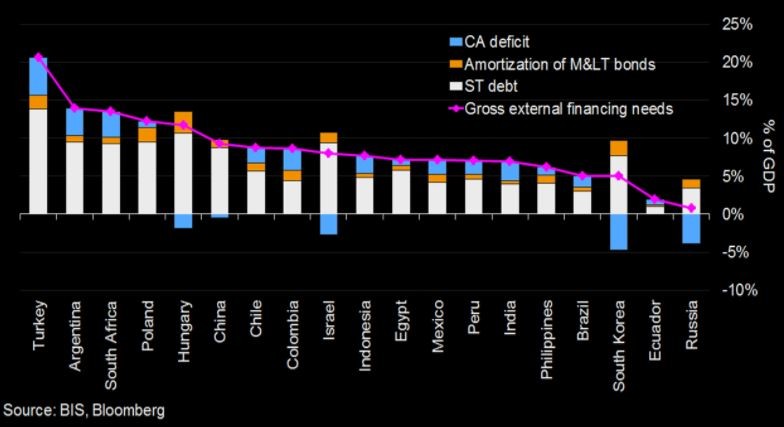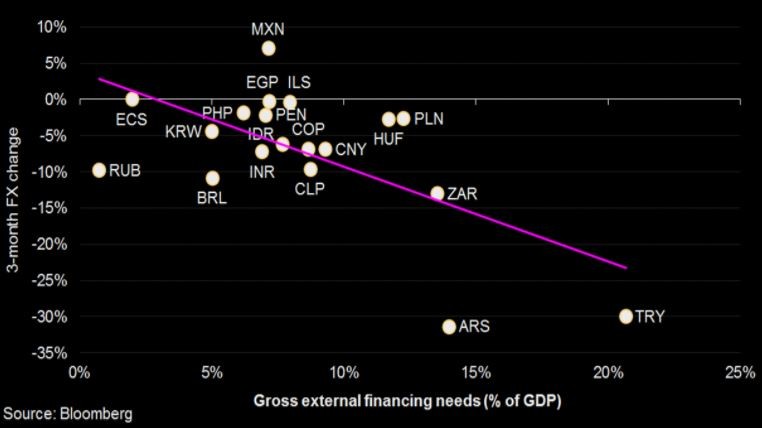Who needs cash? Ranking EM financing gaps
This analysis was written by Bloomberg Intelligence economist Felipe Hernandez. It appeared first on the Bloomberg Terminal.
Tightening external financing conditions and waning risk appetite are posing headwinds for capital inflows into emerging markets. The most vulnerable countries — those with the highest gross external financing needs — are likely to see weakening pressure on their currencies and face increasing policy constraints.
Which emerging markets have the highest external financing needs? Current account deficits provide some of the answer, but not all of it. For a more complete look, we included data on short-term external debt from the Bank for International Settlements (BIS) and Bloomberg data on medium and long-term debt.
- The results show that Turkey, Argentina, and South Africa have the highest gross external financing needs.
- Poland and Hungary are also near the top — reflecting high volumes of short-term debt and amortization of medium and long-term obligations.
- Russia, Ecuador, South Korea and Brazil have gross external financing needs of less than 5% of GDP, the lowest in our sample.
Gross external financing requirements are commonly defined as short-term debt, plus amortization of medium- and long-term debt, minus the current account balance.
To calculate gross external financing requirements, we took data for short-term external debt as of the end of the first quarter from the BIS and current account consensus forecasts for 2019 from Bloomberg’s monthly survey of analysts in August. For amortization of medium- and long-term debt, we added bond maturities between September 2018 and year-end 2019, per Bloomberg data. This does not include amortization of medium- and long-term loans and other debt instruments, and is likely to underestimate the total amount. However, bonds account for close to half of the total medium and long-term external debt outstanding for the countries in our sample, and the results should provide a useful approximation.
Gross External Financing Needs

Per this approach, Turkey, Argentina and South Africa have the highest gross external financing needs, mainly explained by a combination of high short-term debt and large current account deficits. Additionally, Turkey has high amortization of medium- and long-term obligations.
Poland and Hungary also have relatively high gross external financing needs — more than 10% of GDP — mostly due to their short-term debt and amortization of medium- and long-term obligations. Hungary has a current account surplus, which helps reduce its external financing needs.
Russia, Ecuador, South Korea and Brazil have gross external financing needs of less than 5% of GDP, and are the lowest in our sample. In Brazil and Russia, low short-term debt explains most of this. Russia also has a current account surplus, which reduces its external financing needs. South Korea has high short-term debt and high amortization of medium- and long-term obligations, but also has a large current account surplus.
Countries with higher gross external financing needs are likely to be more vulnerable to changes in global financing conditions. They are also likely to see their currencies weaken and underperform when global financing conditions are tightening.
This is consistent with the negative correlation between gross external financing needs and exchange rate returns in the three months through September. The results help explain the recent sell-off in the Turkish lira, Argentine peso and South African rand.
FX Spot Returns, Gross External Financing Needs

They also suggest that recent weakening pressure on the Brazilian real and the Russian ruble is probably less about tighter external financing conditions and more about political uncertainty ahead of the October election in Brazil and the increasing weight of U.S. sanctions on Russia.
High gross external financing needs have not prevented the Polish zloty and the Hungarian forint from outperforming other emerging-market currencies. Investors seem less concerned about this scenario in these countries, possibly because a significant share of the outstanding short-term debt and amortization of medium- and long-term obligations is denominated in euros. Financing conditions in euros have tightened from a year ago, but are still relatively favorable, and have seen a much more moderate adjustment than those in U.S. dollars.
Data on gross external financing requirements provide useful information about the vulnerability of emerging markets to changes in global financing conditions and helps explain recent currency moves. The results also highlight the limitations of this approach and the need to incorporate additional analysis for a more complete picture.